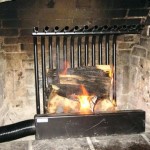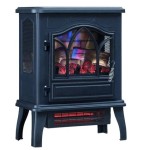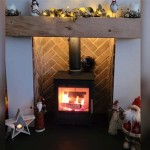Gas Fireplace Lava Rocks and Embers: Enhancing Aesthetics and Performance
Gas fireplaces offer convenience and warmth, providing a readily available heat source with minimal effort. While the underlying technology is consistent across many models, the aesthetic presentation can vary significantly. Lava rocks and embers are commonly used within gas fireplaces to enhance visual appeal and contribute to a more realistic and inviting ambiance. This article explores the properties, functionality, selection, and maintenance of lava rocks and embers within gas fireplace systems.
Lava rocks, derived from volcanic eruptions, are porous stones exhibiting a diverse range of colors, typically including shades of black, gray, and reddish-brown. Their irregular shapes and textures contribute to a natural aesthetic, mimicking the appearance of a traditional wood-burning fire. Embers, often made from ceramic fibers or treated wood, are designed to glow when heated, further enhancing the illusion of burning fuel. The combined effect of lava rocks and embers can transform a functional appliance into a captivating focal point within a living space.
Understanding the Role of Lava Rocks
Lava rocks serve several important functions within a gas fireplace. Primarily, they act as a heat diffuser. The open flame from the gas burner is directed onto the lava rocks, which then absorb and radiate the heat more evenly throughout the fireplace. This process helps to mitigate hot spots and distribute warmth more effectively into the surrounding environment. The porous nature of lava rocks also increases the surface area available for heat transfer, contributing to improved overall heating efficiency.
Furthermore, lava rocks play a significant role in aesthetic enhancement. By concealing the gas burner and creating a bed upon which the flame can dance, they contribute to a more natural and realistic fire appearance. The irregular shapes and textures of the rocks create visual interest and depth, masking the mechanical components of the fireplace and focusing attention on the flame itself. The strategic arrangement of lava rocks can significantly impact the overall visual appeal of the fireplace, allowing for customization and personalization of the fire display.
The selection of appropriate lava rocks is crucial for optimal performance and safety. The size and type of lava rock used should be compatible with the specific gas fireplace model. Using the wrong type of rock, or an excessive amount, can impede airflow to the burner, leading to incomplete combustion and potentially hazardous carbon monoxide production. Always consult the manufacturer's instructions for recommended lava rock specifications.
Exploring the Functionality of Embers
Gas fireplace embers are designed to simulate the glowing remnants of a dying fire. These embers enhance the realism of the fireplace by creating the illusion of hot coals, contributing to a more authentic and inviting ambiance. Typically made from ceramic fibers or treated wood, embers are strategically placed around the gas burner to maximize their visual impact.
Ceramic fiber embers are non-combustible and designed to withstand high temperatures. They absorb heat from the burner and glow brightly, mimicking the appearance of hot coals. These embers are generally long-lasting and require minimal maintenance. Treated wood embers, on the other hand, are designed to slowly char and glow as they are exposed to the flame. This process creates a more realistic ember effect, but these embers will eventually need to be replaced as they are consumed by the heat.
The placement of embers is crucial for achieving the desired aesthetic effect. They should be positioned around the gas burner in a way that maximizes their visibility and creates a natural-looking ember bed. Overcrowding the burner with embers can impede airflow and affect combustion efficiency. Refer to the manufacturer's instructions for specific ember placement recommendations.
Selecting and Maintaining Lava Rocks and Embers
The selection process for lava rocks and embers should be based on several factors, including the specific gas fireplace model, the desired aesthetic effect, and safety considerations. always consulting the fireplace manufacturer's instructions is important to determine the recommended type and quantity of lava rocks and embers for the specific unit.
When selecting lava rocks, consider the size, color, and texture of the rocks. Smaller rocks tend to distribute heat more evenly, while larger rocks create a more dramatic visual impact. The color of the rocks should complement the overall aesthetic of the fireplace and the surrounding room. A variety of textures can add visual interest and depth to the fire display.
For embers, choose between ceramic fiber and treated wood based on the desired level of realism and maintenance requirements. Ceramic fiber embers are more durable and require less maintenance, while treated wood embers offer a more realistic appearance but need to be replaced periodically. When deciding to install treated wood embers, consider the risk of carbon monoxide poisoning. It is advisable to install carbon monoxide detectors when using treated wood embers.
Proper maintenance is essential for ensuring the longevity and performance of lava rocks and embers. Periodically inspect the lava rocks for signs of cracking or deterioration. Replace any damaged rocks to prevent potential safety hazards. Cleaning the lava rocks and embers periodically removes dust and debris that can accumulate over time and affect their appearance and performance.
To clean lava rocks, carefully remove them from the fireplace and gently brush them with a soft brush. Avoid using harsh chemicals or detergents, as these can damage the rocks. For ceramic fiber embers, simply dust them with a soft cloth. Treated wood embers do not typically require cleaning, as they are designed to slowly char and be replaced.
The arrangement of lava rocks and embers can also be adjusted to optimize the visual effect. Experiment with different configurations to find the arrangement that best suits the individual preferences and the overall aesthetic of the room. Avoid overcrowding the burner with rocks or embers, as this can impede airflow and affect combustion efficiency.
Regularly inspect the gas burner and the surrounding area for any signs of leaks or damage. If any issues are detected, immediately turn off the gas supply and contact a qualified technician for repair. Proper maintenance and regular inspections are essential for ensuring the safe and efficient operation of the gas fireplace.
The combined use of lava rocks and embers can significantly enhance the aesthetic appeal and performance of a gas fireplace. By understanding the properties, functionality, selection, and maintenance of these components, the owner can create a warm, inviting, and safe focal point within their living space. The selection of lava rocks and embers is a crucial element in creating a cozy and inviting atmosphere.

Gas Fireplace Embers Friendly Fires

Glowing Embers For Fireplace Mother Daughter Projects

Glowing Embers In A Fireplace Magic Touch Mechanical

Glowing Embers For Fireplace Mother Daughter Projects

Gas Fireplace Logset Lava Rocks Friendly Fires

Williamsburg Gas Logs Cyprus Air Fireplaces Va Md Dc

Pleasant Hearth Vented Or Vent Free Gas Log Embers In The Fireplace Accessories Department At Com

Manchester Oak Gas Logs Cyprus Air Fireplaces Va Md Dc

Unifalsy Gas Fireplace Embers 6 Oz Rock Wool Glowing For Logs

Embers Rocks And Sand Fireplace Parts Accessories
Related Posts








